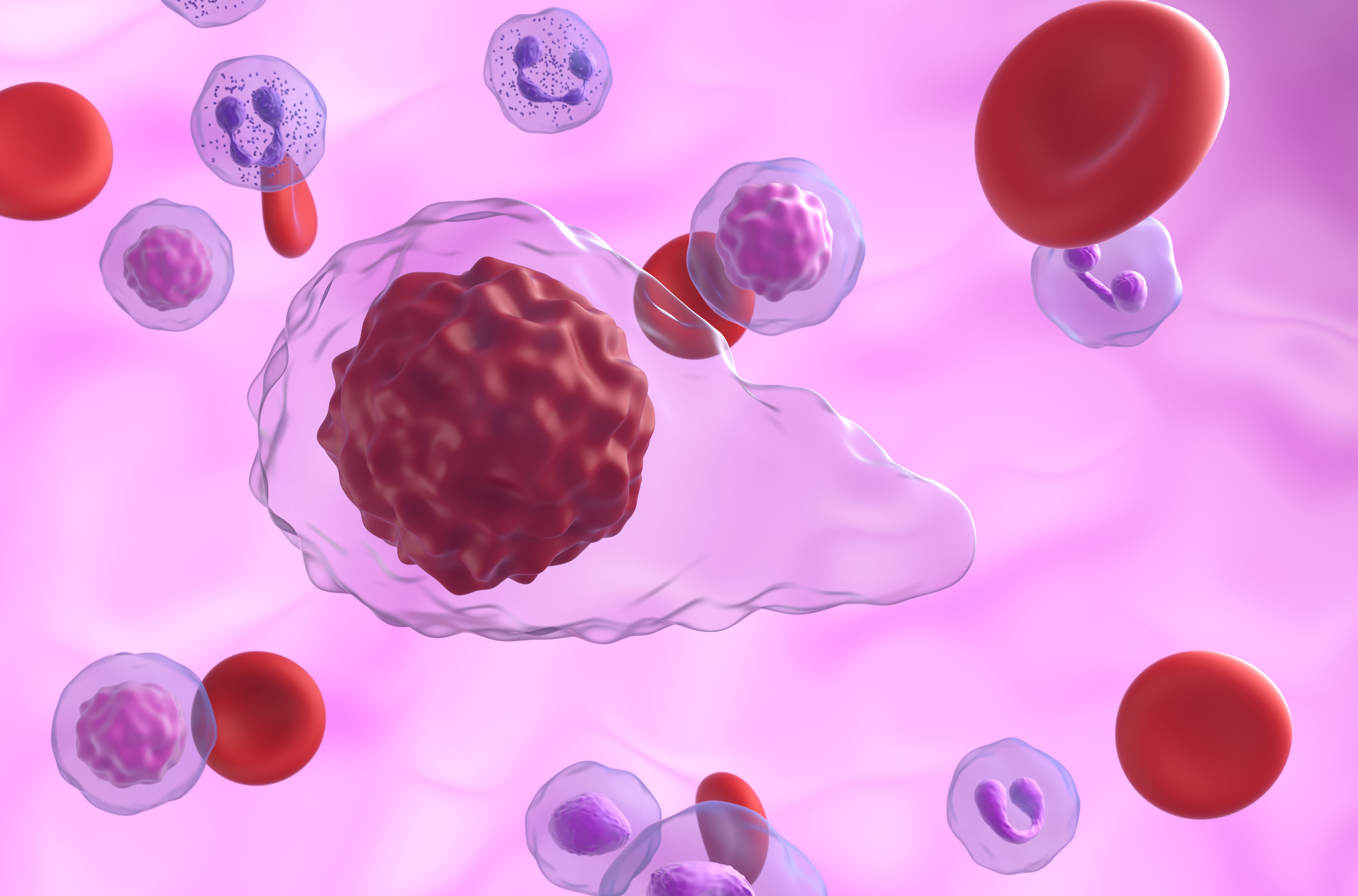Momelotinib Improves Anemia in JAK Inhibitor-Naive Myelofibrosis
Compared with ruxolitinib, momelotinib improved mild, moderate, and severe anemia in patients with myelofibrosis who were naive to JAK inhibitors, according to the phase 3 SIMPLIFY-1 study.
Closeup 3D illustration of primary myelofibrosis (PMF) cells in blood flow: © LASZLO - stock.adobe.com

Treatment with momelotinib (Ojjaara) delivered benefits to anemia among patients with myelofibrosis who were naive to JAK inhibitors, regardless of their baseline hemoglobin level. Further, momelotinib provided significant anemia benefits compared with ruxoltinib (Jakafi), according to an analysis from the phase 3 SIMPLIFY-1 study (NCT01969838).
SIMPLIFY-3 randomized 432 patients with myelofibrosis who had not received JAK inhibitors toreceive momelotinib or ruxolitinib.In patients who were anemic and received momelotinib, mean hemoglobin levels increased by weeks 2 to 4 of treatment, and hemoglobin levels remained stable among patients who were not anemic.
Comparatively, patients who were anemic and nonanemictreated with ruxolitinib experienced an initial decrease in mean hemoglobin. This decrease stabilized after weeks 4 to 6 as patients received red blood cell transfusions. Patients receiving ruxolitinib were permitted to cross over to the momelotinib group, and mean hemoglobin levels increased after this change.
The study also evaluated patients at different levels of anemia. Among patient who were mildly anemic, with ahemoglobin levelbetween 10 and 12 g/dL, 90.4% of patients were transfusion-free at baseline, 93.9% of these patients remained transfusion-free while receiving momelotinib. Four patients who were not transfusion-free at baseline became transfusion-free while on treatment. In contrast, patients who were mildly anemic in the ruxolitinib arm became more dependent on transfusion; 50% of patients who were transfusion-free at baseline required a transfusion while on ruxolitinib.
“While treatment of mild anemia (hemoglobin levels of ≥10 to <12 g/dL) is not always routinely considered, our analysis also highlights the potential value of momelotinib in preserving transfusion independence in eligible patients with mild anemia for whom JAK inhibitor treatment is warranted,” authors of the study published in Leukemia & Lymphoma, wrote.
Regardingpatients who were not anemic, all those in the momelotinib arm were transfusion-free at baseline and remained so. Five patients who were transfusion-free at baseline in the ruxolitinib group required transfusions during treatment.
“While momelotinib demonstrated benefits across anemic subgroups, the impact of momelotinib in nonanemic patients is less clear.”
Among patients who were moderately or severely anemic, 34.1% were transfusion-free at baseline in the momelotinib group. Fourteen of the patients who required transfusions at baseline were able to become transfusion free, and 86.2% of those who were transfusion-free at baseline stayed so. In the ruxolitinib arm, only 30% of the moderately or severly anemic patients who were transfusion-free at baseline remained that way.
No new safety signals for momelotinib were identified. Discontinuation due to adverse events was more common in the moderate to severe anemic population receiving momelotinib (18.8%) compared with ruxolitinib (6.3%). However, dose reductions or interruptions were more common with ruxolitinib vs momelotinib (36.8% vs 21.2%, respectively).
“The clinical benefits and safety profile of momelotinib in JAK inhibitor-naive patients with myelofibrosis across mildly to severely anemic and nonanemic subgroups were generally consistent with those observed in the overall SIMPLIFY-1 trial population, thus representing a potential treatment option for patients with myelofibrosis regardless of baseline hemoglobin levels,” study authors concluded.
REFERENCE:
Gupta V, Oh S, DevosT,et al. Momelotinib vs. ruxolitinib in myelofibrosis patient subgroups by baseline hemoglobin levels in the SIMPLIFY-1 trial. Leuk Lymphoma.Published online March 19, 2024. doi:10.1080/10428194.2024.2328800
Connecting Spleen Volume Reduction to Survival Outcomes in MF
April 21st 2024During a Case-Based Roundtable® event, Raajit K. Rampal, MD, PhD, discussed the correlation between spleen volume responses and survival outcomes for patients with myelofibrosis in the second article of a 2-part series.
Read More
Savona Discusses First-Line JAK Inhibition for Patients With Myelofibrosis at Risk of Anemia
April 17th 2024During a Case-Based Roundtable® event, Michael Savona, MD, and participants discussed the case of a patient with myelofibrosis and moderate anemia receiving JAK inhibitor therapy.
Read More
PTCy Offers New Hope for Mismatched Stem Cell Transplants in Leukemia, MDS
April 13th 2024Jeff Auletta, MD, discussed how PTCy-based graft-vs-host disease prophylaxis offers a promising approach for expanding access to successful cell transplantation regardless of donor match or patient ethnicity.
Read More